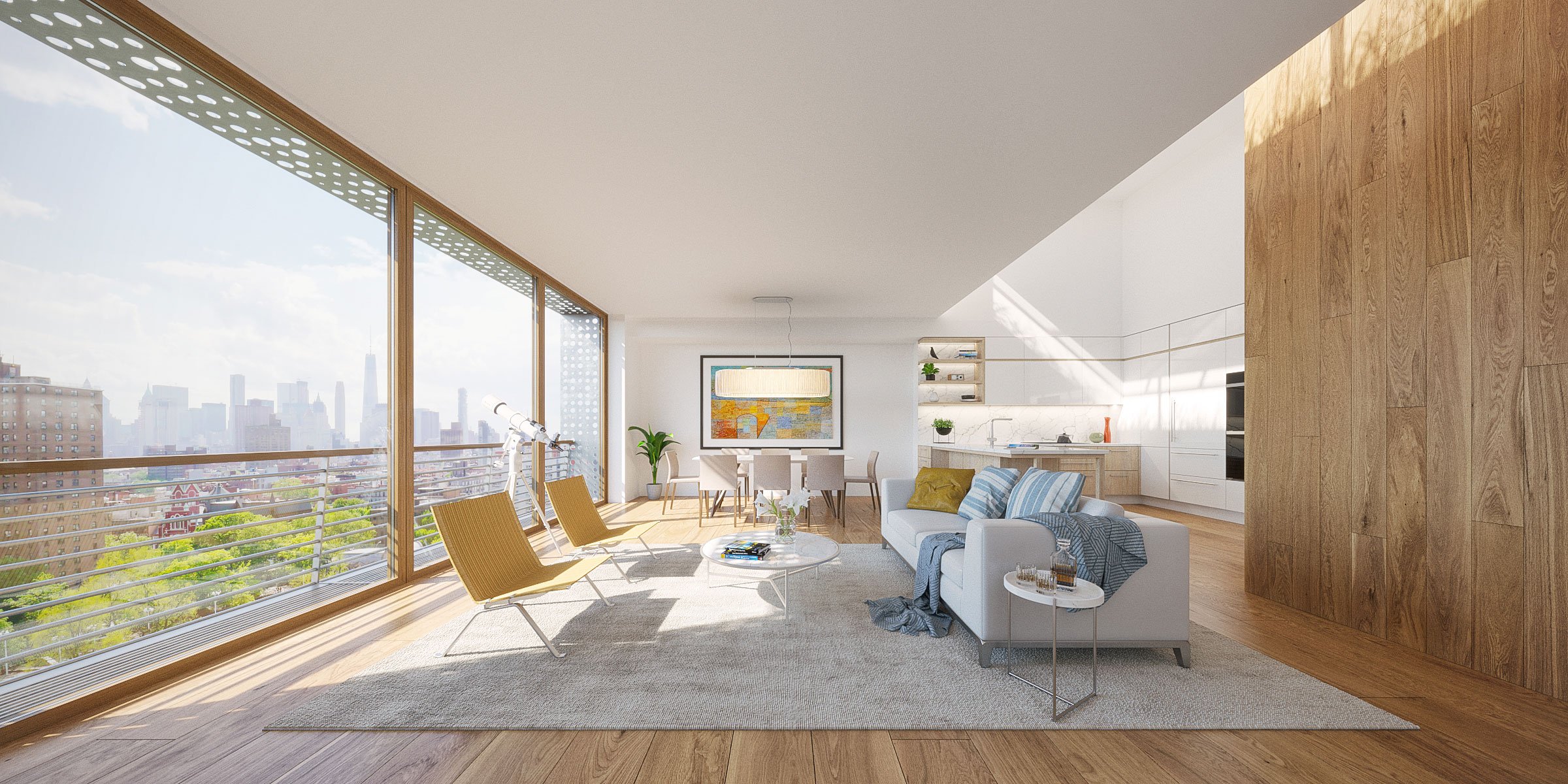
Sustainable Design
A conscious approach to low carbon buildings
Passive House
A standard for building energy-efficient structures with low environmental impact.
Low Carbon Strategies
Improving a building for better energy-efficiency, high-performance and resiliency.
Passive House
Passive House is a standard for energy efficiency in a building, resulting in low-energy consumption for heating or cooling, and reducing a building's ecological footprint.
Benefits
-
Energy usage in a Passive House can be reduced by up to 90% compared to traditional builds through careful craftsmanship involving insulation, improved windows, and heat-recovery ventilation. Energy-efficiency also maintains, and often increases the comfort of internal spaces.
-
In traditional builds, air is filtered through the walls, which can contain mold, pollutants, and allergens. Passive House is carefully sealed, and heat-recovery ventilation systems provide a steady flow of filtered air while exhausting stale air from service spaces. These high-spec envelopes also eliminate cold bridges, which can lead to condensation and mold growth.
-
Passive House can be affordable to build, with cost often offset by more modest heating and cooling systems. Unlike energy-hungry traditional buildings, Passive House requires very little to operate comfortably. Our projects can cost the same as typical construction, resulting in significant long-term savings.
-
The benchmark of Passive House design is to provide the occupant with a comfortable, quiet, and draft-free environment. Every detail is carefully considered, such as heat loss or gain and unnecessary wasted energy on mechanical systems.
Have more questions? Read our FAQs.
Mass Timber
Construction with mass timber uses compressed layers of wood to create structural load bearing components that sequester CO2 and reduce construction costs.
Video of How Mass Timber is Made
Benefits
-
An ecological approach in a world where the construction industry is responsible for 40 to 50 percent of CO2 emissions. Renewable materials such as wood, can help mitigate the rate of global warming. Mass Timber not only sequesters CO2 but also has a much lower embodied energy than concrete or steel.
-
Working with mass timber allows the architect and construction team to front-load the design process and develop details that are then factory built with a high level of quality control and reduction of waste. Components are then delivered to the job site ready for assembly, this allows smaller teams to build more quickly than before.
-
Biophilic design connects occupants to nature in our built environments. Studies point to a growing body of evidence that natural materials, plants, natural light and access to nature relieve stress, the underlying cause of many forms of physical and mental illness. Designing with wood provides the architect the ability to develop both beautiful and healthful spaces. Since wood does not rely on light it can even make a windowless room feel more inviting.
-
Mass timber is sourced from highly-managed forests. Harvesting specific trees for mass timber can encourage forest management and provide:
• much needed thinning for the health of a forest
• a renewable, sustainable building material
• increased employment
This could benefit forests like the ones in the Pacific Northwest that are subject to wildfires due to poor management and climate change, and have been destroyed or weakened by pine beetles.
Have more questions? Read our FAQs.
Low Carbon Strategies
Improving the energy efficiency and sustainability of a building of any size, guided by building type, climate, and budget. With a larger goal of decarbonizing buildings and creating more resilient spaces.
Key Strategies
-
A well-insulated building will require little additional heating or cooling, resulting in lower energy costs and greater comfort.
-
Older or poorly made windows are one of the primary sources of heat loss and gain. Investing in well-constructed windows will increase comfort and save money. The best windows should last for 20 years or more, and are typically thermally-broken, extremely airtight, triple-glazed and use low-e glass to improve thermal performance.
-
Removing gas and oil from your home reduces the possibility of fire and carbon monoxide exposure. The pathway to a fossil-free future, an all-electric building not only reduces operational costs but also provides a healthier indoor environment. Three significant areas that can be electrified:
• Installing electric appliances
• Installing a heat pump or mini-split to heat and cool
• Installing an electric water heater
-
It may seem inconsequential but lighting choice plays a significant role in the carbon efficiency of any building. When compared to more common light bulbs such as incandescent light bulbs, LEDs emit 80% less carbon dioxide and require 75% less energy.
These incandescent bulbs are in fact so inefficient they are now banned by the Department of Energy. Starting in August 2023, Americans will no longer be able to buy incandescent bulbs!
Without a doubt LED lighting is considered to be the best choice due to their cost efficiency, longevity and environmental benefits.
-
Installing solar panels on your roof is a great way to save energy costs — and they don’t have to look ugly. There are federal, state, and city incentives to help offset initial costs. Once installed, the excess energy can be stored for personal use or sold to an electricity network or grid.
Wondering if solar panels make sense for your home? Check out Google’s project Sunroof.
-
Are you in a potentially high-risk zone? For example, if you are in a flood zone, you can plan an upgrade to raise mechanical and electrical systems out of the flood plain.
Have more questions? Read our FAQs
See more about ZH’s experience with low carbon strategies in NYC
FAQs
Passive House
-
Passive House buildings can look similar to traditional buildings, however underneath the appearance, they have a few distinguishments:
More insulation to create a very thermally resistant envelope.
Junctions in the envelope are carefully designed to avoid thermal bridging, air-leakage, and drafts.
State-of-the-art windows: usually high-spec thermally broken units which typically have triple glazed, gas filled glazing to keep a tight control on heat loss/gain.
Ventilation: With the help of a Heat Recovery Unit (HRV), heat is removed from exhaust air, and used to heat incoming air to maintain a stable indoor temperature.
-
Yes! This construction strategy works on any project type. We anticipate there will be many adopters of this construction technique as it becomes more widely recognized and energy codes become more stringent. We are excited to see this transition.
-
Yes, but only marginally—really! Some Passive Houses are built for the same cost as traditional construction, and sometimes less, but typically, the cost is up to 10% more for a higher quality build. Often the cost is offset by a massive reduction in energy bills, and the elimination of heavy mechanical heating and cooling units. Costs are steadily decreasing as Passive House becomes more normalized worldwide.
-
We are not sure how this misconception started.You can open your windows. Go ahead and feel the breeze outside, or listen to the birds in the morning — fling that window wide open. Because these buildings are designed for comfort, you will never need to open your windows to keep cool or to air out the house.
-
Repeat after us, “Passive Homes need not be boxy!” Just like all architecture, Passive Houses come in all sorts of shapes, sizes and colors. There are some beautiful buildings being designed all around the world.
-
We really like to make a point about this. The term passive house can be misleading. There are no physical limits to the size -OR- building type that can be built to the Passive House standard. The bigger the building, the bigger the energy savings.
-
Yes, you can! Check out this interview with Itzy and Bo, who are Ditmas Park home owners. They have graciously shared their personal experience in retrofitting their home in Brooklyn
Mass Timber
-
The surface of mass tiimber chars slightly during a fire, which insulates the interior wood from being damaged. Due to that quality, a structural engineer can easily size the outer layer to the required fire rating.
-
Wood’s strength-to-weight ratio is competitive with steel, but it weighs considerably less, reducing the load on the foundation during seismic events and making for a resilient and safe structure.
-
Although it varies per jurisdiction, the 2021 International Building Code approved three new construction types that allow mass timber structures up to 9, 12 and 18 stores high. The NYC Council has approved the use of mass timber in buildings up to 85’ tall and a maximum of 7 stories.
-
Mass timber is sourced from highly-managed forests or tree stands*, not from complex forest ecosystems that develop over a long time. These tree stands are typically publicly-owned and managed by government authorities. Strategies such as calculated thinning, increased drainage, and intensive reforestation typically increases and renews the size of the stand.
*A stand is an aggregation of trees or other growth occupying a specific area and sufficiently uniform in species composition, size, age, arrangement, and condition as to be distinguished from the forest or other growth on adjoining areas.
-
ZH’s visit to Nordic's CLT/Glulam Factory in Quebec documents the process of how harvested wood from sustainably managed forests is transformed into Mass Timber. See it HERE.
Low Carbon Strategies
-
Agreed, many electric stove tops are less than ideal but induction cooking is a better alternative. Advantages include, not hot-to-the-touch, faster meal prep, precise temperature control, and easy to clean. Read more about induction cooking and the myths around them.
-
Yes, it is possible to air seal only a portion of your home. Some people choose to leave the basement or attic out of the passive house envelope. Another example would be to add a passive house addition to your home.
-
Yes! Many older buildings may need to improve their carbon footprint with incremental strategies. This can be upgrading building components such as windows, insulation, ventilation step by step until better performance or PH standards are met. You can also choose to retrofit entire portions of your home in stages. In both of these approaches it is important to create a master plan early in the process to create a logical and cost effective plan. ZH has implemented step by step programs in both single and multi family homes. You can see an example of a multifamily project doing step by step HERE.
-
Poorly insulated buildings cause their heating and cooling systems to work continuously to maintain desired temperatures leading to high carbon emissions and costly energy bills. Creating a properly insulated building is both environmentally conscious and saves you money - a win/win.








